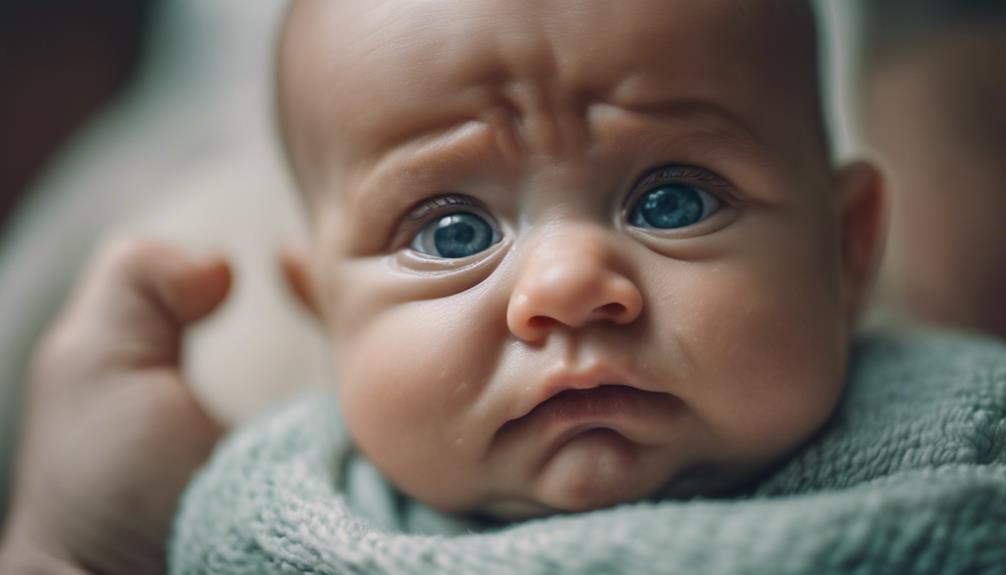When your baby is constantly smiling, it shows genuine happiness and positive emotional well-being. Different types of smiles, such as Duchenne and social smiles, can provide insights into their growth and connection with you. Understanding the emotional advantages, like stress reduction and bonding, can help shape your caregiving approach. Babies often reflect their parents’ expressions, underscoring the impact you have on their smiles. Cultural beliefs regarding baby smiles vary between societies. Distinguishing between genuine and reflex smiles enables you to respond appropriately to their signals. Creating a cheerful atmosphere through constructive interactions and regular care boosts your baby’s happiness and well-being.
Key Takeaways
- Genuine baby smiles signify happiness and engagement.
- Positive interactions with caregivers enhance smiling.
- Babies regulate emotions through smiling patterns.
- Cultivate a happy environment for consistent smiles.
- Understanding cultural perspectives enriches the significance of baby smiles.
The Psychology Behind Baby Smiles
Explore the fascinating psychology behind baby smiles to uncover the intricate world of infant emotions and social interactions.
Babies display a unique type of smile known as the Duchenne smile, characterized by raised cheeks and eye crinkles, which signifies genuine joy and engagement. Contrary to common belief, research suggests that infants can exhibit social smiles as early as the first month of life, indicating intentional communication rather than reflexive responses.
These differences in babies' smiling patterns can be linked to their individual temperament and affective style, showcasing the diversity of emotional expression even at a young age.
Newborns also demonstrate early social competence by actively regulating their states through smiling to seek interaction or sleeping to avoid stress, highlighting their innate ability to engage with their environment.
Caregivers play a significant role in this process by frequently smiling at newborns, which not only influences their social behavior but also contributes to their emotional development.
Emotional Benefits of Baby Smiles
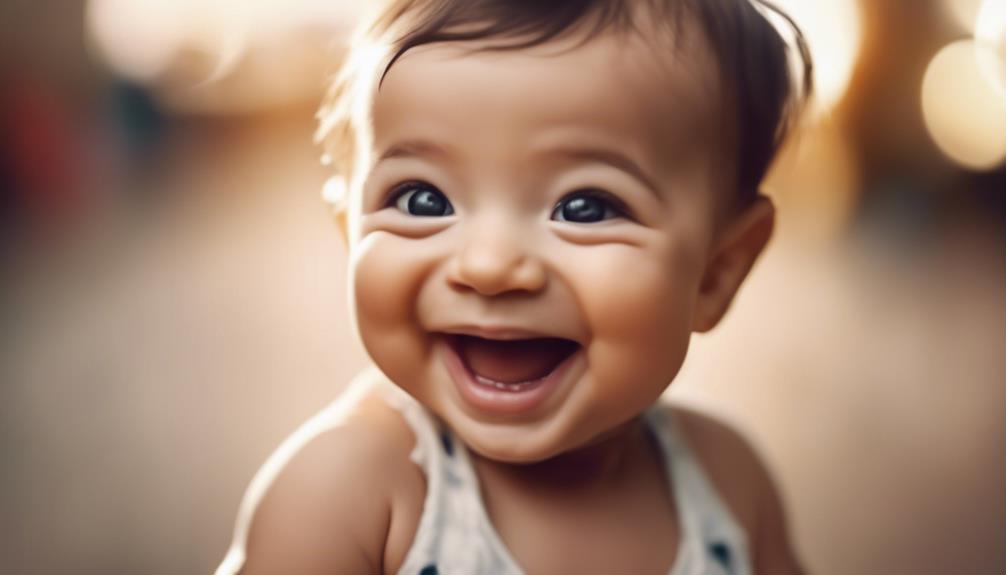
When babies smile, they ignite a cascade of joy within you, triggering the release of feel-good chemicals like endorphins. These tiny grins not only fill your heart with warmth but also help lower stress levels by reducing cortisol, the body's stress hormone.
Connecting through baby smiles creates a bond that nurtures emotional well-being and strengthens the foundation of relationships, fostering a sense of joy in small moments.
Joy in Small Moments
Experiencing the emotional benefits of baby smiles can greatly enhance feelings of happiness and security for both the caregiver and the baby. Infants smile as early as a few weeks old, displaying their first social smile that serves as a powerful tool for bonding and emotional connection.
Here are some key points to keep in mind:
- Baby smiles release chemicals that promote feelings of happiness and security in both the baby and the caregiver.
- Smiling frequently at a baby strengthens the parent-child bond and enhances the baby's emotional development.
- Babies look to their caregivers' faces for comfort and attention, making smiling interactions essential for their well-being.
- Smiling at a baby shows appreciation, love, and acknowledgment of their presence and emotions.
- Regular smiling interactions with a baby provide positive early experiences that contribute to their overall happiness and emotional health.
These small moments of joy through baby smiles lay the foundation for a strong emotional connection and well-being.
Connection Through Smiles
Building positive connections and forming secure attachments, baby smiles serve as an essential form of emotional communication between infants and caregivers. From the moment babies enter the world, smiling as a reflex allows them to navigate the social world around them.
Research indicates that babies who receive frequent smiles from caregivers exhibit greater social competence. When caregivers reciprocate these smiles, it fosters a sense of validation, love, and understanding in babies.
The act of smiling at a baby triggers the release of feel-good chemicals in the brain, promoting emotional well-being and happiness. This exchange of smiles not only benefits the baby but also strengthens the bond between caregivers and infants.
Baby Smiles and Social Interaction
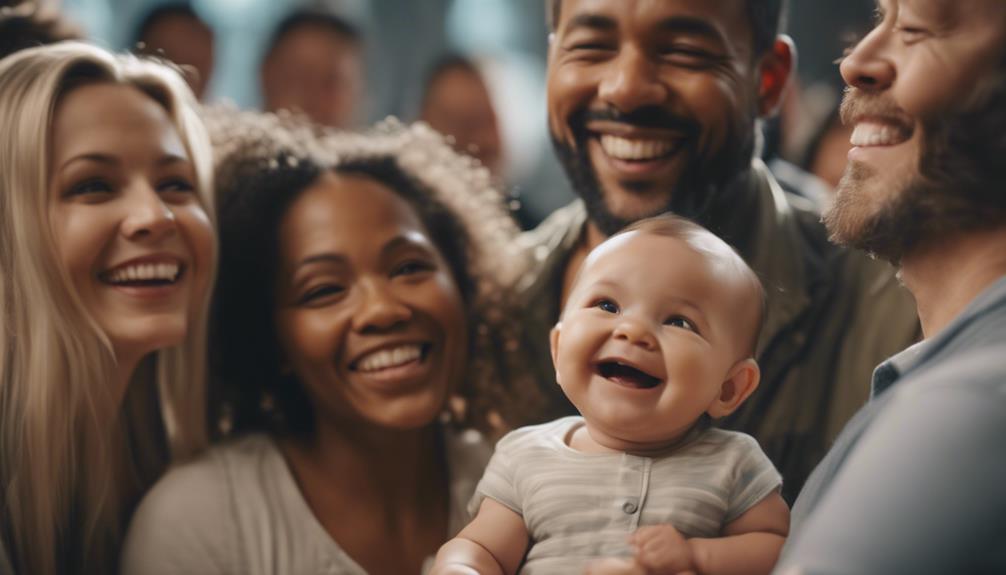
Babies' smiles serve as powerful tools for forging connections and fostering bonds with those around them. These innocent expressions not only convey joy but also act as essential social cues, signaling happiness and contentment.
Understanding the nuances of baby smiles can provide valuable insights into the intricate world of social interaction and emotional communication.
Smiles and Bonding
Through their smiles, babies establish strong emotional bonds and social connections with caregivers, fostering a sense of security and well-being. Research indicates that smiling at a baby plays a crucial role in building a robust emotional connection, as babies use smiles as a form of social interaction and bonding.
When caregivers respond with smiles, babies experience an increase in feel-good hormones, contributing to the development of positive relationships. Furthermore, babies tend to smile more during interactions with familiar faces, particularly parents, highlighting the significance of these early social engagements.
Smiling back at a baby not only reinforces their behavior but also encourages further social interaction, creating a cycle of positive reinforcement and strengthening the bond between caregiver and child.
- Smiles are a vital form of social interaction for babies.
- Caregivers' smiles release feel-good hormones in babies.
- Babies smile more during interactions with familiar faces, especially parents.
- Smiling back at a baby reinforces their behavior.
- Smiling creates a positive cycle of social engagement and bonding.
Social Cues in Smiles
Smiles from babies serve as essential social cues, indicating their desire to interact and connect with caregivers and others around them. These social smiles, also known as Duchenne smiles, go beyond mere facial expressions by conveying genuine engagement and positive emotions.
Infants use smiles not only to seek attention but also to initiate joint attention with objects and people, showcasing their early social development. Anticipatory smiles, observed typically between 8-12 months, play an important role in predicting future social behavior and competence in children.
Moreover, the positive emotional expressions displayed by parents and caregivers have a notable impact on infants' happiness and overall social development. By understanding the significance of smiling as a social cue in babies, caregivers can foster healthy social interactions and emotional well-being in infants, laying a strong foundation for their future social competence.
Interpreting Different Types of Smiles

Have you ever wondered how different types of smiles can reveal a baby's emotional state and social interactions? Understanding the nuances of infants' smiling patterns can provide valuable insights into their expression of joy and engagement.
Here are some key points to explore:
- Babies often display Duchenne smiles, characterized by raised cheeks and crinkled eyes, to indicate genuine happiness and connection.
- Authentic smiles, which activate the left frontal part of the brain, are commonly seen in response to familiar faces or comforting stimuli.
- Variations in infants' smiling patterns may be linked to their temperament and developing affective style over time.
- Newborns can demonstrate social smiles, involving mouth movements and eye contact, as early as the first month of life.
- Interpreting the types of smiles babies exhibit can offer a deeper understanding of their emotional responses and social interactions.
Impact of Parental Bond on Baby Smiles

Positive interactions with parents play a pivotal role in influencing the frequency and authenticity of baby smiles. Research by Daniel Messinger has shown that babies are highly responsive to their parents' facial expressions, often mirroring their smiles. This mirroring behavior not only reflects the baby's social engagement but also strengthens the parent-child bond. When parents consistently engage with their babies through smiling and positive interactions, it fosters a sense of security and happiness in the child, leading to more frequent and genuine smiles.
| Impact of Parental Bond on Baby Smiles |
|---|
| Babies smile more in response to parents' facial expressions |
| Smiling frequently at a baby strengthens the parent-child bond |
| Quality of the parent-child relationship influences baby smiles |
| Babies look to parents for emotional cues affecting their smiling behavior |
Understanding the relationship between parental interactions and baby smiles can help caregivers create a nurturing environment that promotes the baby's emotional well-being and development.
Cultural Perspectives on Baby Smiles

Cultural perspectives play a significant role in shaping how different societies interpret the significance of baby smiles. When it comes to baby smiles, various cultures have unique beliefs and practices that influence their views on this universal form of communication. Here are some key points to take into account:
- In some cultures, a baby's smile in response to a family member is seen as a symbol of strong familial bonds and emotional connection.
- Cultural perspectives on baby smiles can vary widely, with some societies valuing smiling as a positive omen reflecting a harmonious family environment.
- Certain cultures may have specific rituals or customs associated with smiling infants, incorporating these smiles into traditions or ceremonies.
- Smiling behavior in babies can hold different meanings across cultures, impacting how parents respond to their child's expressions of happiness.
- Understanding these cultural perspectives provides insights into the significance placed on emotional expression and social interactions within diverse societies.
Recognizing Genuine Vs. Reflex Smiles
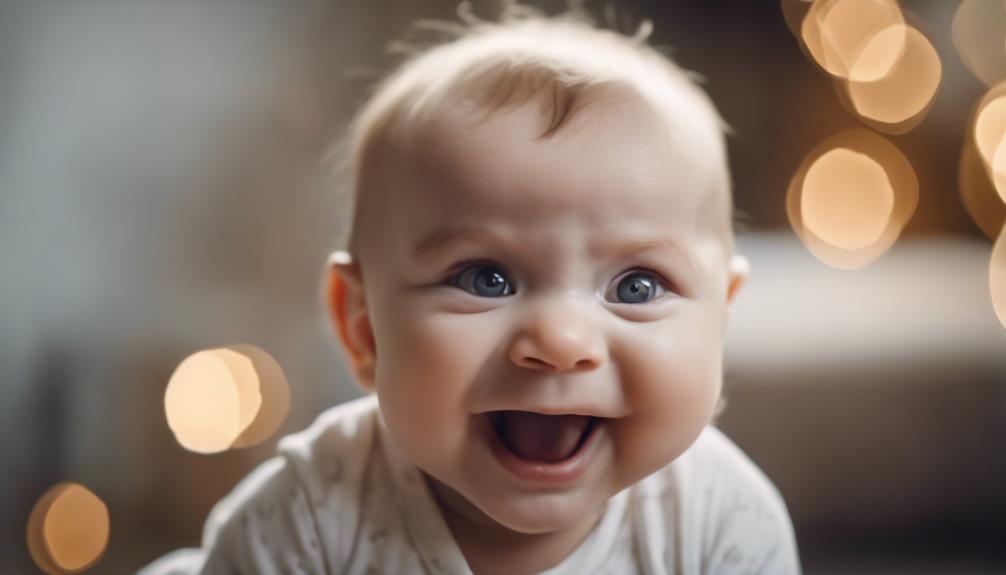
Recognizing the difference between genuine and reflex smiles in babies is essential for understanding their emotional cues and needs.
Genuine smiles, also known as Duchenne smiles, involve muscle movements around the eyes and mouth, indicating true happiness and engagement.
On the other hand, reflex smiles, commonly seen in newborns, are automatic responses to internal stimuli like digestion or gas, not necessarily linked to external emotions.
Research indicates that babies as young as 2 months old can differentiate between genuine and reflex smiles.
Caregivers play an important role in encouraging more genuine smiles by engaging with their babies through eye contact, talking, and play.
By understanding the distinction between these smiles, caregivers can better respond to their baby's emotional needs and cues.
When your baby smiles back at you, pay attention to the subtle cues that may indicate genuine happiness, fostering a deeper connection and a happier environment for your little one.
Nurturing a Happy Environment for Baby
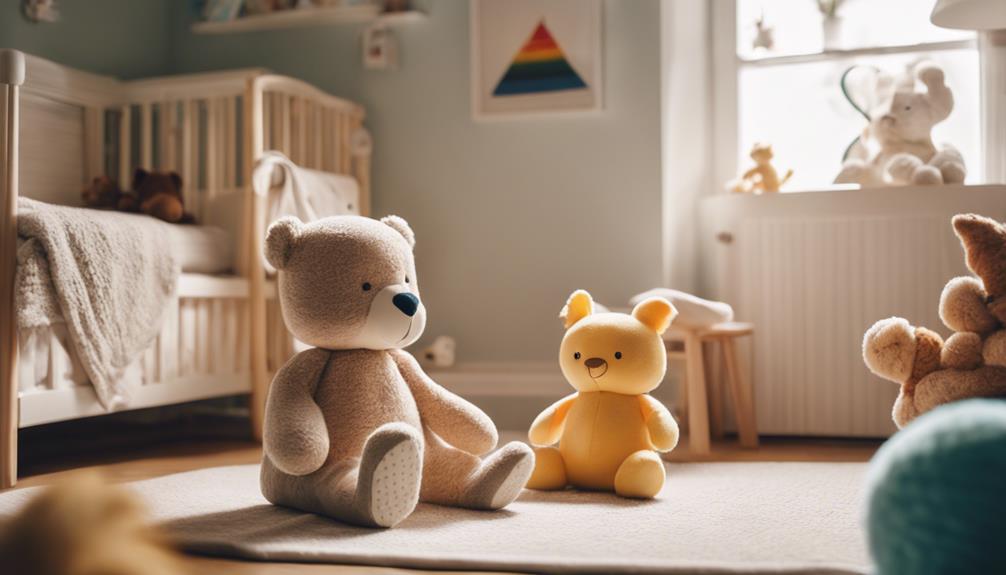
Creating a nurturing and joyful environment for your baby involves engaging in positive interactions and responding warmly to their smiles. Research suggests that smiles occur frequently in babies as a form of communication and emotional expression. By actively participating in these smile-filled interactions, you can greatly contribute to your baby's emotional well-being and overall happiness.
Here are some key ways to nurture a happy environment for your baby:
- Engage in positive interactions such as playing, talking, and cuddling with your baby.
- Respond to your baby's smiles with genuine warmth and affection to strengthen your bond.
- Stay positive and upbeat around your baby, as they're sensitive to your emotions.
- Provide a loving and supportive environment consistently to maintain your baby's joyful disposition.
- Create a routine that includes activities that bring joy and comfort to your baby, promoting a sense of security and happiness.
Frequently Asked Questions
Does Smiling Mean My Baby Is Happy?
When your baby smiles, it doesn't always mean they're happy. Babies smile for connection and learning too. It's a way to communicate with you and explore their world. Respond with love and attention.
Why Is My Baby so Smiley All the Time?
Your baby is so smiley all the time because they are naturally inquisitive and enthusiastic to explore the world around them. Their continuous smiles indicate a healthy and happy mental state, so enjoy those precious moments!
Why Is My Baby Smiling Without Reason?
Your baby smiles without reason as a normal part of their social development. They're processing joy and learning from their surroundings. Enjoy and reciprocate their smiles, as it's a natural way for them to communicate and engage.
Why Some Babies Are Always Happy?
Some babies are always happy due to their innate joyfulness and positive nature. Their natural disposition towards happiness, reinforced by caregivers' positive reactions, contributes to their constant smiles and contentment.
Conclusion
To sum up, understanding the intricacies of baby smiles can provide valuable insights into their emotional well-being and social development. By recognizing the different types of smiles, interpreting their meanings, and nurturing a happy environment, parents can help foster a positive and healthy relationship with their child.
Remember, a smile isn't just a reflex, but a powerful indicator of happiness and connection. So, embrace those joyful grins and watch your baby thrive in a world full of smiles.





